Saturdays, noon to 1 p.m. ET on WICR 88.7 FM.
Or listen live from anywhere on WICR
Online!
Saturdays, noon to 1 p.m. ET on WICR 88.7 FM.
Or listen live from anywhere on WICR
Online!
April 9, 2016 show
|
The American Institute of Architects once asked its members to rank U.S. cities on architectural quality and innovation. Columbus, Ind., finished sixth - behind only the significantly larger cities of Chicago, New York City, Washington D.C., San Francisco and Boston.
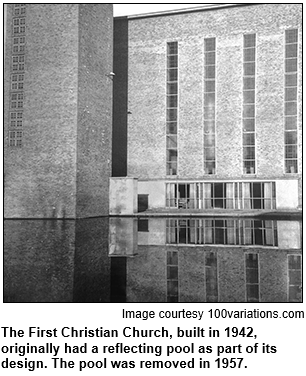 The modern architecture in Columbus (pop.: 45,000) has been showcased in national media ranging from CBS Sunday Morning and USA Today to Travel & Leisure and Smithsonian magazines.
The modern architecture in Columbus (pop.: 45,000) has been showcased in national media ranging from CBS Sunday Morning and USA Today to Travel & Leisure and Smithsonian magazines.
Now it's Hoosier History Live's turn to explore the architectural heritage of the Bartholomew County city with one of its best-known media figures/historians as our guest.
Nelson will be joined in studio by Bartholomew County historian Harry McCawley, the retired associate editor of The Columbus Republic; he continues to write a popular weekly newspaper column that often focuses on local history. Harry, a civic leader who has been president of the Bartholomew County Historical Society, also has edited several books focusing on Columbus history.
Key figures in the story of the Columbus architectural heritage include renowned Finnish architect Eliel Saarinen, who designed the city's First Christian Church in 1942, and his son, Eero Saarinen, who designed the Irwin Union Bank and Trust in 1955 - several years after having designed the Gateway Arch in St. Louis.
Columbus business and civic leaders who spearheaded the crusade to lure top architects with diverse, innovative designs included J. Irwin Miller (1909-2004). For nearly 50 years, Miller was at the helm of Cummins, Inc., a Fortune 500 company based in Columbus that manufactures diesel engines.
Eero Saarinen also designed the Miller House, the former residence of the Miller family that is located on more than 13 acres of landscaped gardens.  The Miller House, which has been featured in Architectural Digest, is owned today by the Indianapolis Museum of Art and has become a popular destination for tours. (Famous furniture designer Charles Eames created furnishings for the Miller family.)
The Miller House, which has been featured in Architectural Digest, is owned today by the Indianapolis Museum of Art and has become a popular destination for tours. (Famous furniture designer Charles Eames created furnishings for the Miller family.)
In downtown Columbus, historic structures include the Irwin family's ancestral home, which was built during the Civil War era. Today, it is a bed-and-breakfast called the Inn at Irwin Gardens.
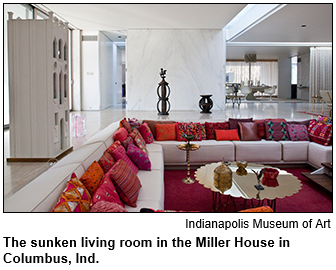 Our guest Harry McCawley will share details about the origins of the city's architectural heritage. Much of the trigger was the critical need for new schools for children of the baby boom generation; Miller is said to have looked at the unimpressive design for a school and said, "We certainly can do better than this."
Our guest Harry McCawley will share details about the origins of the city's architectural heritage. Much of the trigger was the critical need for new schools for children of the baby boom generation; Miller is said to have looked at the unimpressive design for a school and said, "We certainly can do better than this."
The eventual result has been dozens of award-winning designs and sites listed on the National Register of Historic Places.
In addition to First Christian Church, a National Historic Landmark that is considered to be the first American church designed in a contemporary style (it has indirect lighting and interior brick walls, both considered cutting-edge in 1942), several other houses of worship are architecturally significant. They include North Christian Church (designed by Eero Saarinen with a hexagonal roof topped by a towering spire); St. Peter's Lutheran (Gunnar Birkerts was its architect), and First Baptist Church, designed by Harry Weese of Chicago, who also was the architect for some local schools.
The glass-walled Columbus Republic newspaper building also is considered architecturally significant; according to Harry McCawley, it "spurred downtown redevelopment."
During our show, Harry also will share insights about the beginnings during the 1800s of Columbus, which has marketed itself with the slogan: "Different By Design."
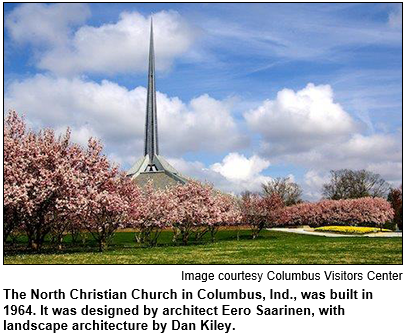 When the city was founded in the 1820s, it briefly was known as Tiptonia in honor of Gen. John Tipton, an early landowner. Following a dispute between Tipton and county officials, he left the area ("In a huff," according to our guest Harry McCawley) and the town was renamed Columbus; the disgruntled general allowed his name to be attached to Tipton and Tipton County farther north in Indiana. For various reasons - including his ruthless treatment of the Potawatomi Indians - Gen. Tipton is a controversial figure in Indiana history.
When the city was founded in the 1820s, it briefly was known as Tiptonia in honor of Gen. John Tipton, an early landowner. Following a dispute between Tipton and county officials, he left the area ("In a huff," according to our guest Harry McCawley) and the town was renamed Columbus; the disgruntled general allowed his name to be attached to Tipton and Tipton County farther north in Indiana. For various reasons - including his ruthless treatment of the Potawatomi Indians - Gen. Tipton is a controversial figure in Indiana history.
Fast-forward to issues in the 20th century about attitudes toward minorities. Under the leadership of J. Irwin Miller during the 1960s, "Cummins used corporate muscle in forcing Realtors and landlords" to end discriminatory practices toward African Americans, Harry McCawley says. "(Miller) wanted the community opened to people of all colors mostly because it was the right thing to do, but also because Cummins was trying to attract top young executives and engineers from elsewhere."
That also was part of the motivation for encouraging impressive architecture in Columbus, Harry notes. Miller and other business officials, he says, "felt the need to provide prospective leaders of their community with surroundings that might keep them in the community for decades instead of using Columbus as a stepping stool on their individual career resumes."
The distinctive architecture, Harry emphasizes, "was as much a business decision as it was to provide residents with a model community."
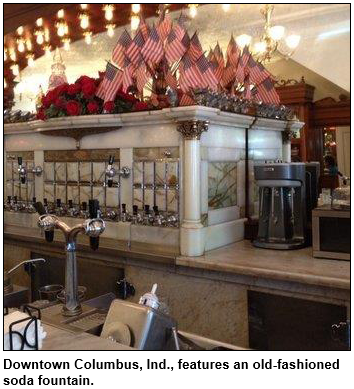 A popular destination for visitors to Columbus is an ice cream parlor that opened in 1900. Founded by three brothers from Greece, the landmark eatery has a tin ceiling, a self-playing pipe organ, a mahogany back bar, stained-glass windows and a soda fountain museum.
A popular destination for visitors to Columbus is an ice cream parlor that opened in 1900. Founded by three brothers from Greece, the landmark eatery has a tin ceiling, a self-playing pipe organ, a mahogany back bar, stained-glass windows and a soda fountain museum.
Although the historic ice cream parlor no longer is owned by descendants of the three Greek brothers, the family's name has been retained on the landmark eatery. In 2009, the ice cream parlor reopened after being closed for two years for a major renovation.
Question: Name the landmark ice cream parlor in Columbus.
Please do not call in to the show until you hear Nelson pose the question on the air, and please do not try to win the prize if you have won any other prize on WICR during the last two months. You also must give you first name to the engineer in order to be placed on the air.
The prize pack includes a gift certificate to the Claddagh Irish Pub and Restaurant, two tickets to the Benjamin Harrison Presidential Site, courtesy of Visit Indy, and four tickets to the premier of the "Roots of Destiny"documentary about the Indiana ancestral home of Barack Obama in Tipton County, courtesy of the Dunham House Educational Foundation. The premier is Saturday evening, April 30, at the Ricks Centre in Greenfield.
Guest Roadtripper and public historian Glory-June Greiff suggests a Roadtrip to Demotte and Jasper County in northwestern Indiana. She tells us that "this part of the state was, for the most part, settled much later than the rest of the state, owing to the vast and seemingly impassable swamps, which were largely drained in the late 19th century."
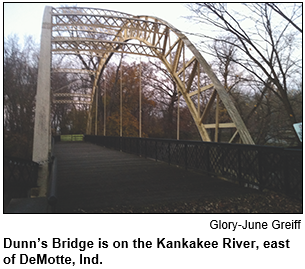 Glory continues: "Today we call those wetlands, and some are being restored. Driving in this country of wide open spaces can be disconcerting! Jasper County, at the southern edge of this region, has many interesting sights."
Glory continues: "Today we call those wetlands, and some are being restored. Driving in this country of wide open spaces can be disconcerting! Jasper County, at the southern edge of this region, has many interesting sights."
Founded in 1882, DeMotte owes its existence to the railroad that still runs through town. At the corner of 9th and Birch is the DeMotte Library, a branch of the Jasper County Public Library system, housed in a former Catholic church that was expanded to four times its original size in 1992. The library is also home to the DeMotte Historical Society.
Hungry? Just off Highway 231 at the south edge of DeMotte is Jim's Cafe, open for breakfast, lunch and supper.
"This my kind of small-town cafe," Glory says, "but if it doesn't float your boat, DeMotte has plenty of other restaurants. Just cruise the main drag, which is 231."
Several miles due east of DeMotte is the fascinating Dunn's Bridge, which several years ago was in a decrepit state.
"This is the so-called Ferris Wheel bridge," Glory says, "and there is a good case to be made. The bridge is looking much better these days, and the county has created a very nice little park around it, with a picnic area and canoe launch into the Kankakee River."
Farther east is Jasper-Pulaski Fish & Wildlife Area, where in spring, but especially in late fall, you can see thousands of sandhill cranes. They're harder to predict in spring, but always worth a look!
Your Hoosier History Live team,
Nelson Price, host and
creative director
Molly Head, producer, (317)
927-9101
Richard Sullivan, webmaster
and tech director
Pam Fraizer, graphic
designer
Garry Chilluffo, media+development director
Please tell our sponsors that you appreciate their support: Indiana Authors Award | Indiana Historical Society | Indiana Landmarks | Lucas Oil | Scott Keller Appraisals | Society of Indiana Pioneers | Story Inn | Yats Cajun Creole Restaurant

 Acknowledgments to Monomedia, Visit Indy, WICR-FM, Fraizer Designs, Heritage Photo & Research Services, Derrick Lowhorn and many other individuals and organizations. We are an independently produced program and are self-supporting through organizational sponsorships and individual contributions. We do not receive any government funding. Visit our website to learn how you can support us financially. Also, see our Twitter feed and our Facebook page for regular updates.
Acknowledgments to Monomedia, Visit Indy, WICR-FM, Fraizer Designs, Heritage Photo & Research Services, Derrick Lowhorn and many other individuals and organizations. We are an independently produced program and are self-supporting through organizational sponsorships and individual contributions. We do not receive any government funding. Visit our website to learn how you can support us financially. Also, see our Twitter feed and our Facebook page for regular updates.
April 16 show
With the 100th running of the Indianapolis 500 next month, all aspects of the history of Indy car racing and its colorful personalities have become topics for water-cooler discussion.
Significant racing personalities of the last half of the 20th century certainly include the Bettenhausen family, who have endured tragedy as well as triumphs at the Indianapolis Motor Speedway and elsewhere on the racing circuit. The patriarch, Tony Bettenhausen Sr. (1916-1961), a fan favorite who finished near the top in the 500-Mile Races of 1958 and '59, was killed in a crash at the Speedway during practice in 1961.
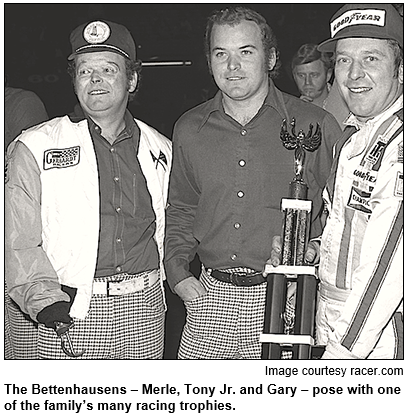 Nelson will be joined in studio by the middle of Tony Sr.'s three sons, Merle Bettenhausen, who lives on the westside of Indy.
Nelson will be joined in studio by the middle of Tony Sr.'s three sons, Merle Bettenhausen, who lives on the westside of Indy.
Merle has been working with veteran sportswriter Gordon Kirby on an upcoming photo-filled book about the family, Tony Bettenhausen & Sons: An American Racing Family Album (Racemaker Press).
In 1972, Merle's brother, Gary Bettenhausen, nearly won the Indianapolis 500. Gary, who lived in Monrovia, was enjoying a comfortable lead at 175 laps when he was forced out with ignition problems.
Also in 1972, Merle Bettenhausen was involved in a major accident at Michigan International Speedway in which his right arm was torn off. With a prosthetic arm, Merle made a comeback the next year, competed in midget races and pulled off wins.
The youngest brother, Tony Bettenhausen Jr., competed 11 times in the Indy 500. His best finish was in 1981, his rookie year, when Tony Jr. came in seventh. Gary and Tony Jr. drove in their final Indy 500 as teammates in 1993.
Tragedy followed the family even after the brothers retired as drivers. In 2000, Tony Jr., by then the owner of a racing team based in Indy, was killed along with his wife, Shirley, and two business associates in the crash of a private plane.
Merle, our guest, was 17 years old when his father was killed in May of 1961. Tony Sr. was test-driving the car of a fellow driver when the fatal accident occurred.
Gary Bettenhausen also endured a major accident. He suffered serious, permanent injuries to his left arm during a crash in Syracuse, N.Y., in 1974. Yet he continued his career as a race driver for nearly 20 more years.Gary Bettenhausen died at age 72 in 2014.
The upcoming book is divided into sections (with on- and off-track photos) focusing on Tony Sr., Gary, Merle and Tony Jr., along with personal recollections and commentary by Merle.
"It's doubtful there's ever been a more determined or star-crossed family in auto racing history than the Bettenhausens," Robin Miller, the well-known sportswriter and racing commentator, has written. "But throughout their victories, gut-wrenching defeats and tragedies, it was a family shaped by hard work and heart."
Additional research by Jeff Kamm.
© 2016 Hoosier History Live! All rights reserved.